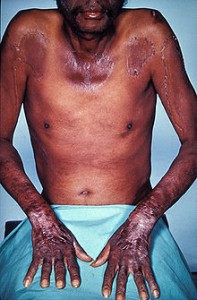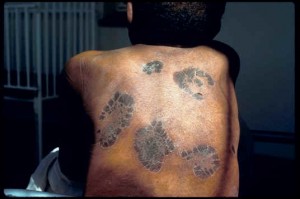Have you been lately suffering from diarrhea, insomnia and skin rashes that turn worse on being exposed to sunlight? If you are, Pellagra could be the underlying condition. Read and know all about this nutritional disorder, including its various causes, symptoms, diagnosis, and treatment options.
Pellagra Definition
Page Contents
- 1 Pellagra Definition
- 2 Pellagra ICD9 Code
- 3 Pellagra History
- 4 Pellagra Etymology
- 5 Pellagra Incidence
- 6 Pellagra Causes
- 7 Pellagra Risk Factors
- 8 Pellagra Symptoms
- 9 Pellagra Diagnosis
- 10 Pellagra Differential Diagnosis
- 11 Pellagra Treatment
- 12 What is Alcoholic Pellagra?
- 13 Pellagra Management
- 14 Pellagra Complications
- 15 Pellagra Prognosis
- 16 Pellagra Prevention
- 17 Pellagra Pictures
It is a disorder arising due to lack of adequate amounts of niacin, a B complex vitamin, or an amino acid named Tryptophan in the body of an individual.
The condition is also known by other names like Niacin Deficiency or Vitamin B3 deficiency.
Pellagra ICD9 Code
The ICD9 Code for this condition is 265.2.
Pellagra History
The condition was first described by a Spanish court physician named Don Gasper Casal in 1735 when he reported about its prevalence in poor peasants of the Spanish Asturias province.
Pellagra Etymology
The name of the disorder owes its origin to a similar Italian term that stands for “rough skin.”It is obviously a reference to the thickened skin observed in sufferers of the disorder. In the United States, the disease was first reported in the year 1902.
Pellagra Incidence
The exact incidence of the condition is not known. However, a sizeable population of the world is believed to be affected by the disorder. The condition does not show any racial or sexual predilection. During a Pellagra epidemic in the U.S, a higher prevalence of the condition was noted in children, women and elderly people of both sexes.
Pellagra Causes
The condition may arise due to:
- Reduced consumption of niacin
- Lower intake of tryptophan
- Excessive alcohol intake for many years
- Excessive consumption of Leucine
- Gastrointestinal disorders
- Deficiency of Lysine, an amino acids
- Changes in protein metabolism, due to diseases like Carcinoid Syndrome
The disorder often arises when the body is unable to absorb nutrients like niacin or tryptophan from foods, as in patients of digestive disorders. Reduced amounts of these nutrients in diet can automatically make a person prone to Pellagra.
Pellagra Risk Factors
As already said, partial or complete absence of niacin or tryptophan in diet can make a person susceptible to this disorder. The condition has a higher incidence in those regions of the world where people consume high amounts of corn. Corn is deficient in niacin. Corn eaters can rectify this problem by using a process called nixtamalization. The technique involves treating corn with lime, thus making it rich in niacin.
In many communities, it is frequently observed in poor people who are malnourished. The condition is also quite common in:
- Anorexics
- Chronic alcoholics
- Individuals suffering from acute mental disorders, who may show a refusal to consume foods
This is believed to be an adult disease, meaning adults are at greater risk of developing this disorder than children or elderly individuals. However, young children and adolescents could develop the disease if subjected to a non-niacin diet. The condition rarely arises at the time of infancy.
Pellagra Symptoms
People affected by this disorder typically suffer from the following difficulties:
- Scaly sores on skin
- Swelling of mucous membranes
- Diarrhea
- Aggression
- Delusions
- Dilated cardiomyopathy
- Red lesions on the skin
- Insomnia
- Mental confusion
- Smooth red glossitis
- Ataxia
- Edema
- Alopecia
- Paralysis of the limbs
- Peripheral neuritis
- Extreme sensitivity to sunlight
The disorder typically manifests in the late stage of niacin or tryptophan deficiency. It is first manifested by a photosensitive rash on the skin (rash that becomes severe on exposure to light) accompanied by digestion problems. Patients may experience a burning sensation in the rashes and find blisters developing over the regions at a later stage. In the later stages, the affected skin regions tend to thicken and become brown and scaly in appearance.
In the later stages, patients begin to exhibit neurological problems. Suffering individuals have trouble in maintaining balance and ultimately develop Dementia.
Pellagra Diagnosis
The diagnosis of this disorder involves:
Consideration of medical history
The medical history of sufferers is taken into account. Sufferers are questioned about the symptoms that they have been experiencing, diet and supplements they are taking and whether or not they consume corn products.
Physical examination
Physicians look for photosensitive rashes in patients suspected of having Pellagra. Pellagra is chiefly characterized by the development of symmetrical red rashes (dermatitis) on the face, arms, feet and back of hands of it sufferers. The rashes look like sunburns and worsen on being exposed to sunlight, revealing photosensitivity in patients. Presence of such rashes is a further confirmation of the nutritional disorder.
Tests
A 24-hour urine collection is usually ordered by physicians diagnosing this syndrome. Patients have to collect all their urine for a 24-hour period and hand it over for laboratory analysis. The sample is assessed for by-products of niacin. The level of such by-products helps physicians determine the extent of niacin deficiency in sufferers. In some cases, blood samples may also be collected and analyzed.
Pellagra Differential Diagnosis
While conducting a differential diagnosis, doctors attempt to make sure that the symptoms are actually a result of Pellagra and not of similar disorder like:
- Pemphigus
- Porphyria
- Atopic dermatitis
- Drug eruptions
- Lupus erythematosus
- Contact dermatitis
- Neurological disorders
- Bacterial, viral, or parasitic gastrointestinal (GI) infections
Pellagra Treatment
Earlier, the dermatitis of kwashiorkor has been mistaken for Infantile Pellagra. The condition is usually treated by the use of nicotinic acid, along with changes in diet, to make sure that a sufferer gets the nutrition that meets bodily requirement in future. Niacin and tryptophan can be found in rich doses in foods like:
- Yeast
- Wheat
- Poultry
- Peanuts
- Organ meats
Those eating a balanced diet comprising of such foods can easily avoid nutritional deficiency disorder, such as Pellagra. Physicians should be consulted with to know about a proper diet which can counter the effects of this disease. Patients would also find it assistive to have a consultation with an expert nutritionist.
Diet supplementation is not only necessary for Pellagra sufferers but also for individuals having restricted access to fresh foods that contain rich amounts of vital minerals and vitamins. Patients should be administered with supplements of B-vitamins as many of them are found to be deficient in B1, B2 and B6 vitamins as well as Pantothenic acid.
In patients suffering from severe inflammation of the tongue and the mouth, difficulties in swallowing may arise. This can necessitate the introduction of a soft or liquid diet.
In some cases, especially advanced stages, treatment is usually conducted with nicotinamide, a chemical associated with Niacin.
What is Alcoholic Pellagra?
It is a disorder affecting chronic alcoholics or people who consume alcohol over a long period of time. While Pellagra usually results from a deficiency of niacin in diet, Alcoholic Pellagra occurs due to malabsorption of minerals and vitamins essential for the functioning of the body. In the absence of correct treatment, the disorder may lead to the death of sufferers.
The treatment for this disease has a two-fold approach: curing the symptoms of the disorder and curing alcohol addiction. The symptoms can be alleviated by effective restoration of niacin to the body and use of medications to cure the problem of malabsorption. Niacin restoration helps reverse the symptoms caused by the disease. However, curing alcohol addiction is the long-term cure for this disorder.
Pellagra Management
In acute cases, patients may require complete bed rest for a number of days in the initial stages. They should avoid exposure to sun in order to prevent worsening of the rashes arising due to Pellagra. Sufferers should strictly follow a diet comprising of foods rich in niacin and Tryptophan to avoid further worsening of their symptoms and ensure gradual recovery from the condition.
Pellagra Complications
If the condition is left without treatment for a long time, sufferers are most likely to die as a result of deficiency of niacin or tryptophan. Untreated Pellagra leads to failure of multiple organs and thus, results in death.
Neuropsychiatric complications associated with the disorder may involve depression, anxiety, hallucinations, delusions and even coma. There can be a gradual deterioration in mental and physical capabilities. In worse cases, even death may occur.
Pellagra Prognosis
Untreated cases of this disorder can lead to the death of patients within 4 to 5 years. Treatment with nicotinamide yields excellent results. A balanced diet, along with nicotinamide treatment and niacin restoration proves to be effective in resolving the symptoms in the majority of cases. In cases where the disorder is caused by some underlying disease, the outcome depends on the treatment of that condition. For instance, problems like chronic alcoholism have to be corrected on an immediate basis to completely cure this nutritional disorder. Once they have been cured, affected individuals do not have to follow any restrictions in work or activities.
Pellagra Prevention
Individuals with a high corn-consumption should incorporate foods rich in Niacin and Tryptophan into their diet to prevent the development of the disorder. Aggravation of this condition can be prevented by avoiding exposure to sunlight during the active phase of the disorder. On recovery, patients must stick to a proper diet (rich in Niacin) to avoid a recurrence of the condition. Otherwise, the problems (such as delusions, rashes or neuropsychiatric symptom) could come back again.
Alcoholics should bring down their level of alcohol consumption to a minimum or even try to give up the habit to negate the risk of relapse into the disorder. If that is not possible, alcohol addicts should get in touch and seek assistance from support organizations that help kick the addiction.
Pellagra Pictures
Take a peek at these photos to know how the condition affects the skin appearance of individuals.
Picture 1 – Pellagra
Picture 2 – Pellagra Image
If you, or any of your family members, suspect yourself to be exhibiting the symptoms of this nutritional disorder, seek medical attention as early as you can. Delay in treatment can not only make the condition debilitating for you, but also make you susceptible to various ailments and complications that can be extremely dangerous for health. Naturally, it is sensible to seek medical cure on an early basis and ensure chances of a faster recovery.
References:
http://www.ncbi.nlm.nih.gov/pubmedhealth/PMH0001382/
http://www.mdguidelines.com/pellagra
http://www.medscape.org/viewarticle/727372_3
http://www.britannica.com/EBchecked/topic/449241/pellagra




No Responses